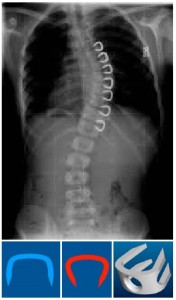Vertebral Body Stapling – State of the Art Scoliosis Surgery?
Latest Research Says Why at this Time it CANNOT Replace Modern Scoliosis Bracing or even Invasive Spinal Fusion Surgery.
The current standard medical approach to nonsurgical treatment for Idiopathic Scoliosis is limited to observation and bracing. Meaning, though other treatment methods exist, patients are generally advised to watch-and-wait or use out of date, ineffective traditional bracing methods. Due to conflicting research on the efficacy of traditional bracing and new innovations in surgical intervention, a recent study compared the outcome of traditional bracing methods to that of a relatively new alternative to spinal fusion surgery, Vertebral Body Stapling (VBS).

The study looked at immature patients with “high-risk (Risser 0-1) moderate (25-44°)” idiopathic scoliosis and compared them to 121 braced patients of which 52 patients were matched according to age at start of treatment and gender.
What Were the Findings?
Both outdated, ineffective bracing and VBS results in similar outcomes for young patients with moderate idiopathic scoliosis.
What Types of Bracing were Included?
The bracing test group used in this study was obtained from a database, which is fairly common practice in research. However, this test pool consisted of patient’s data between the years 1963-1994. As the article itself states:
“Until 1974, patients were treated with a Milwaukee brace (cervicothoracolumbosacral orthosis, or CTLSO) and then after 1974 a Boston brace (thoracolum-bosacral orthosis, or TLSO). “
Since this study specifically used patients from 1965-1990, the comparison is specifically between ineffective and out of date traditional CTLSO and TLSO type bracing and VBS. It does not include newer methods such as over-corrective bracing.
The authors acknowledge the conflicting research associated with these older bracing types in their introduction and suggest that this can be attributed to poor compliance due to the “psychosocial ramifications of brace wear” (the patients wouldn’t actually wear the brace because they didn’t like the way it looked).
They conclude that:
“These results suggest that VBS could be used as an alternative or adjunct to bracing for patients with these curve ranges who are struggling with the ramifications of brace wear.”
Hey! Wait just a minute here!!
If the outcome of a surgical treatment for scoliosis yields similar results to that of a non surgical method (that is arguably out-dated and ineffective), does it really qualify as an alternative or supplement purely because patients might not want to wear a brace?
Key Question Here…
What would the results have shown if the researchers had compared Vertebral Body Stapling Surgery to modern EFFECTIVE, COMFORTABLE and MOSTLY INVISIBLE forms of scoliosis bracing?